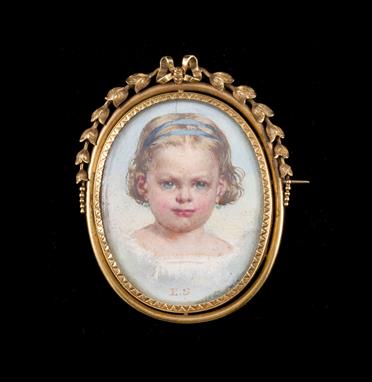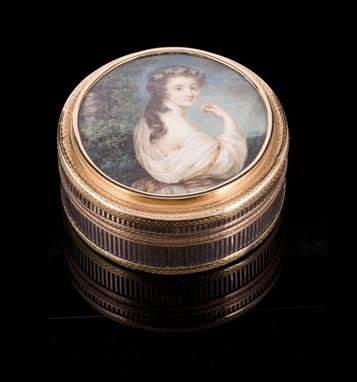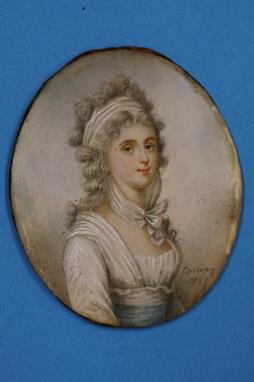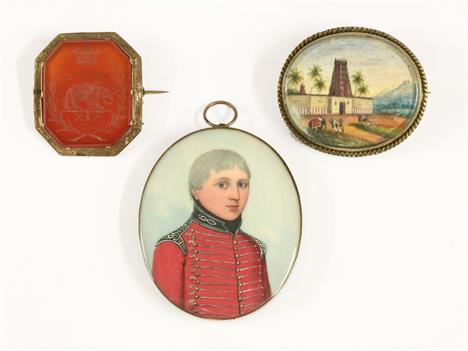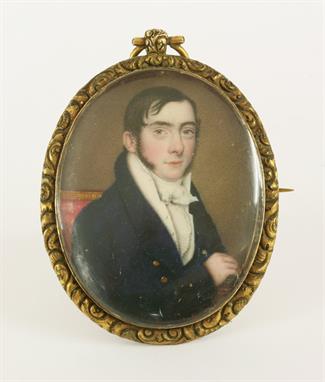We found 31366 price guide item(s) matching your search
There are 31366 lots that match your search criteria. Subscribe now to get instant access to the full price guide service.
Click here to subscribe- List
- Grid
-
31366 item(s)/page
Boite ronde en or et émail bleu le couvercle centré d`une miniature sur ivoire portrait de femme de qualité attribuée à Sicardi - Diamètre : 7cm - Poids brut : 130,9g (petit fêle) Circular gold and blue enamel box , the cover with a gouache miniature of a Lady - Diameter : 2,7in. (little crack)
Nicholas de Garis Snr. (British, early 19th century) Portrait of a young girl, seated on a red chair with ringlets in her hair wearing a waisted blue dress and holding a book in her right hand watercolour, signed verso, inscribed in pencil `Drawn by N.de Garis Snr. June 21st 1841, Guernsey. 11 x 9 cm. * There is a reference printed in Chapter XVII of Jacobs Annals of Guernsey pp465 `Guernsey is not greatly behind the rest of the world in the fine arts; for we posses an elegant landscape painter in oils, Mr J.Young. who is also a portrait painter; besides two native artists, Mr Le Page in portrait and miniature painting; and Mr de Garis in miniature painting.`
A SMALL INDIAN SILVER BOX, UNMARKED, LATE 19TH CENTURY oval, the sides engraved with scrolling foliage, the hinged lid set with a glazed Indian miniature portrait 4.3cm wide The portrait is that of Bahadur Shah II (1775-1862), last Mughal emperor who, following his involvement in the Indian Rebellion of 1857, was tried and exiled by the British to Rangoon.
English School (c.1815), PORTRAIT OF CAPTAIN THOMAS MARTIN, 19TH LIGHT DRAGOONS oval miniature, hung in a gilt wood oval frame 6 x 5cm with written label 'Fought at the Battle of Assaye (1803), was ADC to Lord Lane', together with an intaglio 'Assaye' cornelian brooch, and an Indian miniature brooch (3) CONDITION REPORT: No cracks. Gilt frame has many cracks in the gesso. Gilt mount dirty and needs replacing. Not inspected out of frame.
A group of items belonging to Lieutenant William O'Neill relating to the capture of the rebel leader Keppitipola Disawe on 28th October 1818 during the Uva Rebellion in Ceylon (Sri Lanka) comprising: A Ceylonese silver mounted kastane, early 19th century, the sheath repoussé with rococco scrolls enclosing cornucopia between simulated weavings and studs, the hilt bidri wear, parting due to rusting, the scabbard tip of dolphin head form, watered steel blade, engraved mark 62.5cm long blade 75.5cm long overall; A Dagger, with a leather sheath; PORTRAIT OF LIEUTENANT WILLIAM O'NEILL, English School, Oval watercolour miniature, 6.5 x 5cm, in a giltwood frame 27 x 4.5cm overall, and two copies of General Orders; dated 14th August 1818 and 31st October 1818, framed (5) The Uva Rebellion, also known as the Third Kandyan War, was centred on the Kandyan nobility and their unhappiness with British rule since 1815. It was one of the first major uprisings against European rule in the nineteenth century. Ceylon (Sri Lanka) achieved independence in 1948. William O'Neill, was the youngest son of John and Ann O'Neill, and was born at Parkhill, County Cork, Ireland, in 1800. His family had military blood running through their veins - his great-great-great grandfather on his mother's side was the illustrious Gustavus Hamilton, 1st Viscount Boyne; his great-great grandfather, Captain Charles Stewart, lost a leg at the Battle of Boyne, and his great-grandfather, Richard Babington, was one of the Defenders of Derry. His older brother, Charles O'Neill, served in the Peninsula War and fought in no fewer than twenty-three battles. William followed him to the Iberian Peninsula as a volunteer with no post nor rank and received no pay, a system which allowed young men of good family, usually those who were unable to purchase an ensigncy to serve in the ranks in the hope of succeeding to an ensign's commission. His brother, in the 83rd's first action in the successful assault on the fortress of Ciudad Rodrigo, fought, but William appears not to have taken part as he had only been with the regiment for two months. His brother was seriously wounded on the assault of Badajoz. He was appointed Ensign to the 83rd Regiment and was present at battles of Salamanca, the Capture of Madrid and Retairo, the Retreat from Madrid and Salamanca, the Battle of Vittoria, the Blockade of Pampluna, the Battles of the Pyrenees, Nivelle, Nive and Orthes, and actions at Sauveterre, Vic Bigorre and Tarbes, and the Battle of Toulouse. He received the Napoleonic War Medal with eight clasps. He served in Ceylon during the Kandyan War between 1817 and 1819, and was the officer who made the two Kandyan chiefs, together with many of their followers, prisoners, which at once put an end to the rebellion. For this, he received the thanks in General Orders of the Governor and Commander-in-Chief, Sir Robert Brownrigg. He died as Colonel on 29 September 1869. An extract from his wife's, Florinda Eccles, will, dated 1898, 'to Colonel Robert C Martin I bequeath the silver sword, dagger, medal and likeness of my former husband, Colonel William F O'Neill'. A letter by William O'Neill kept by the family and dated Kahala, 28 October 1818, recounts the capture of Keppitipola: 'To: Captn Fraser, Commg Detachment Parrawahegamma 'Dear Sir, I am happy to have it in my power to report to you, the Capture of Pilama Telewa and Cappitapola (sic) this day by me about 3 o'clock P.M. I marched this morning about 4 o'clock from Pouliencolom and after 4 long Singalies Miles I fell in with the piquet under a Tree, but the moment they saw us they run off in different directions one of them that had a firelock I pursued and after a chase of about 300 yards across a Paddy Field I Knocked him down with a stick which I had in my hand. He then immediately told me Pilama Talawa was close. I then took the whole of my Detachment and crossed Paddy Field as quietly as I could and I am happy to say succeeded in the object of my Pursuit. The whole of their followers run off leaving twenty stand of excellent arms and a quantity of ammunition, which I will destroy, there was also taken a Small bag of Sulphur which I will bring on with the Arms. Kappitipola says he joined Pilama Talawa this Morning and states he left Dombera about 20 days ago. I intend moving in the morning into the 7 Korles to a Village called Poutawille, 4 English Miles from here, and I will (?halt) at some Village further on until I hear from you. Two Prisoners have this moment come in, that was taken by Pilama Telawa near Kornegalle. PS. The men are very much fatigued as it rained the whole way and the roads were complete rivers for about 8 miles.' After his capture, Keppetipola Disawe, was taken to Kandy, tried for high treason and sentenced to death by beheading. On 25 November 1818, he and another rebel leader were taken to the execution grounds outside Kandy at Bogambara, where he requested his executioner to behead him with a single stroke. Tying his hair over his head and uttering some Pali verses, the executioner killed him on the second stroke. His skull was taken to Britain and placed in the Phrenological Society of Edinburgh. Upon independence, he was declared a national hero and, in 1954, his skull was returned home and is entombed in the Keppetipola Memorial. A Transcript of the General Orders 31st October 1818 The Commander of the Forces congratulates His Majesty's and the Honourable Company's Troops under his command on the Important and decisive event of the Capture of the two principal Rebel Leaders Cappilapola and Pilema Telawa, which may be considered as the death blow to the Rebellion which their efforts have successfully been pointed at to subdue. This important capture was effected in consequence of the unceasing and unremitting pursuit and exertions of Lieutenant William O'Neill of His Majesty's 83rd Regiment during the most inclement weather and with many privations. This enterprising Officer marched at 8 o'clock on the night of the 26th and came on the residence of these and the third noted rebel, Madugalle, and other Inferior Leaders, near the Parawahagamma on the borders of the Thorles and Nuwera Kalaweay on the 27th in the afternoon, after a dreadful and fatiguing march of thirty-six miles through a country not known by Europeans, and under every disadvantage, both from the want of Provisions and a knowledge of the Country which never was traversed before by any European and the roads entirely blocked up by trees which had been felled the day before to prevent their being taken by surprise. Lieutenant O'Neill marched at 8 o'clock on the night of the 26th Inst. from Pauliencolom with a Detachment of about Thirty Men to seach the Country in the neighbourhood of Parawahagamma, having previously extorted information from a Moor Man and after a March of 36 English Miles he fell in with a Rebel Picket(?) under a tree, who fled in different directions, one of whom Lieut. O'Neill singled out and pursued, and after a chase of about three hundred yards across a Paddyfield, when on the point of being seized, the fellow fired his piece but happily did not do more than cut Lieutentant O'Neill's coat. This Gallant Officer disregarding all personal danger, rushed in on the fellow and knocked him down with a stick he had in his hand, when he immediately exclaimed that Pilema Tellawa was close at hand. Lieut. O'Neill, impatient to seize on the Chiefs, ran on to the village without a single Soldier with him, but called out to his Detachment to follow as fast as they could. On his entering the village, the Rebels to the amount of Eight Thousand commenced running off and firing from the Jungle and Houses…notwithstanding this, Lieutenant O'Neill took possession of the door of the House and maintained it until his small but gallant band came up, he then gave orders to break open the door, on which the Enemy fired a Volley out at him when they cut his coat in four different places and unfortunately killed six and wounded four of his Men, however, this sad disaster did not daunt the courage of this gallant and experienced Officer, who had already distinguished himself, but boldly headed the remainder of his men and rushed into the House and made prisoners of the two leading Chiefs and 91(?) of their followers. Lieut. O'Neill in his report mentions the Enemies loss at 270 killed and wounded with ninety-one prisoners, he also speaks in the highest terms of the good conduct of his Detachment. They were deluged with rain through the march and had been without Arrack [PALM WINE] for 40 days and frequently without provisions for forty-eight hours together. The Commander of the Forces requests Lieutenant O'Neill and his gallant detachment will accept the just tribute of his cordial thanks for this distinguished and important service and in communicating this gratifying intelligence to the troops, he directs that the usual extra allowance of Arrack on days of rejoicing be issued on the day these orders reach the different stations of the Army. A Transcript of the General Orders 14th August 1818 The Commander of the Forces does not delay publishing to the Army intelligence this day received from _______ of events which are so creditable to the Troops at large and so particularly Honourable to Lieutenant William O'Neill of his Majesty's 83rd Regiment, that the Lieut. General feels unable to express in adequate terms his admiration and thanks. Lieutenant O'Neill took post at Hangrenketty to which place he had come in pursuit of the Insurgents who appear to have collected their forces in that neighbourhood, under the personal Command of the Rebel Desave Cappitapola [DISAWE KEPPETIPOLA], and supposed to be accompany'd by the Pretender. On the 26th of July large bodies of Rebels had nearly surrounded that post, being well armed with muskets, and their numbers amounting to not less than 6 or 7000 men, with this force they began on that day to attack Lt. O'Neill, who had not more than 40 Rank & File to oppose them. But, nothing was impossible to such Men commanded by such an Officer, and although the Rebels continued their close attack till(?) the 7th Instant, they were at all times repulsed by this Gallant Corps, and their loss must have been very great, for the soldiers only fired when they were sure of their aim, and several shells were thrown with effect among the assailing multitudes. Although most of the principal Leaders in this Rebellion were present at these attacks, they were obliged to relinquish the contest confirming(?) their inability to cope with our troops and dispersed for their several villages on the 7th and 8th saying (as letters from Badulla state on good authority ) that they had suffered much, that they were going home to wait for a more favourable time to expel the English, which would be revealed to them by the Gods of Kattragam. Several Head Men were found dead on the field of Battle supposed to be from Wallassy, and reports had reached Badula that the elder(?) Hapattagamme Mohattale had also been killed. To increase the satisfaction experienced in narrating these gallant efforts, it is most gratifying to the Lieut. General to add that not one Man on our side is reported to have been hit. Lieut. O'Neill found near Hangrenketty 8000 Marcals of Paddy and 400 Marcals of Salt which is now well secured. The Commander of the Forces requests Lieut. O'Neill will accept his best and warmest acknowledgements for the distinguished manner in which he has conducted his incessant and active duties throughout the present Campaign and, in particularly, during the ten days he has passed at Hangrenketty, in almost continual action. Lieutenant O'Neill will be pleased to express in equal terms of praise the Lieutenant General's acknowledgements to the Men, Commissioned Officers and Soldiers of his brave little band who had the good fortune by their intrepidity(?) and endurance of fatigue to signalize(?) themselves on the occasion now commented upon and which in its consequences has, it is confidently to be hoped, given a Material Check to the cause of Rebellion. CONDITION REPORT: Kept by the family. The Will and letter are NOT part of this Lot and will NOT be offered for sale. The family believe this sword was acquired during his time in Ceylon.
English School, PORTRAIT OF A LADY WITH A WHITE MUSLIN BUFFON AND CREAM DRESS an oval portrait miniature brooch with an amethyst border, to an outer border of Swiss cut amethysts, to a gold frame and back 3 x 2.8cm 3.7 x 3.2cm overall CONDITION REPORT: Some surface wear to the glass. Crown facet damage and wear to the amethysts. Later brooch fittings.
*Winifred Sandys (1875-1944), PORTRAIT OF A YOUNG GIRL, BUST LENGTH, WITH FLOWERS IN HER HAIR, TREES AND A STREAM IN THE BACKGROUND Miniature on ivory, signed l.l., circular 5.5cm diameter Winifred Sandys was the daughter of the Victorian artist, Frederick Sandys. *Artist's Resale Right may apply to this lot. CONDITION REPORT: Loose in the frame. Image appears to be stuck to the glass. Frame rubbed.
JACQUES NOËL MARIE FREMY (1782-1867). ECOLE FRANÇAISE. « Portrait du Maréchal Poniatowsky en uniforme de général de division du duché de Varsovie » " portant la Légion d’honneur et l’Ordre de Saint Jean de Jérusalem. » Miniature ovale sur cuivre. 11 x 8 "5 cm. Cadre marqueté. B.E. 600/800€ Biographie : Jacques-Noël-Marie Fremy (1782-1867) élève de David et de Regnault peintre d’histoire et de portraits. Provenance : Vente Massol du 09/02/2005.
DANIEL SAINT (1778- 1847) Attribué à Portrait de l’Impératrice Joséphine avec sa parure de perles Rare miniature ovale sur ivoire. Porte une ancienne étiquette manuscrite au dos : « Impératrice Joséphine. Miniature...1820 » Sous-verre. Encadrement en laiton doré et ciselé. Epoque 1er Empire B.E. 12 x 9 cm (avec cadre) 2 000/3 000 € Biographie : Daniel SAINT est considéré comme l’un des plus grands miniaturistes français du XIXe siècle. Né à Saint-Lô en 1778. Il fut l’élève de Jean-Baptiste Regnault (École de David) puis d’Augustin et d’Aubry. Il réalisa de nombreux portraits de la famille Bonaparte (impératrice Joséphine Napoléon Ier Reine Hortense) des souverains de la Restauration (Prince Eugène) et de la monarchie de Juillet (Charles X). Il revint à Saint-Lô en 1842 où il mourut en 1847. Le musée des Beaux-Arts de la ville possède quelques exemplaires de ses œuvres. S’écartant de la méthode d’Isabey qui procédait par le pointillé et de celle d’Augustin qui avait recours au glacis à l’exemple d’Aubry il employa les hachures obtenant ainsi des effets de vigueur dans les tons et de relief dans le modèle. Œuvres en rapport : - Châteaux de Malmaison et Bois-Préau Médaillon pendentif représentant l’impératrice Joséphine par Daniel Saint (1778-1847) vers 1812. - Châteaux de Malmaison et Bois-Préau Portrait ovale de l’impératrice Joséphine avec sa parure de perles par Daniel Saint (1778-1847). vers 1805-1810. - Paris musée du Louvre portrait de l’impératrice Joséphine (1763-1814) par Daniel Saint (1778-1847). - Wesquehal 2004 Quand Bonaparte devint Napoléon p.67.
THÉRÉSA (OU THÉRÉSIA) CABARRUS (1773-1835 dite Madame TALLIEN «Portrait de femme à la couronne d’œillets bleus.» Signée et datée Thérésia 1820. Sous-verre cerclage doré. H : 12 cm 1 000/1 200 € Biographie : CABARRUS Jeanne Marie Thérèse Princesse de CARAMAN-CHIMAY (1773-1835) peintre en miniature amateur. Thérèse Thérésia ou Térésa Cabarrus fille de banquier se maria trois fois d’abord très jeune avec Monsieur Devin de Fontenay puis au Conventionnel Tallien. Célèbre pour sa beauté Madame Tallien surnommée Notre-Dame de Thermidor finit par divorcer en 1802. Après de nombreuses liaisons elle devint comtesse de Caraman princesse de Chimay. Ses miniatures semblent dater d’après son dernier mariage en 1805. L’une d’elles figurant l’Impératrice Joséphine fut montrée à l’exposition de South Kensington à Londres en 1865.
Interesting collection of bijouterie including cross section of fossilised mammoth bone, treen lidded pot, cut throat razor, cold painted dachshund, De la Rue threepence duty playing cards,vintage pens including silver,Conway Stewart 226 and a 14ct gold nibbed Blackbird, hallmarked mother-of-pearl fruit knife, pencil portrait miniature and some vintage keys
-
31366 item(s)/page


